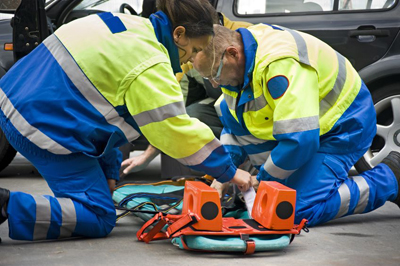Occupational First Aid
Occupational First Aid: Fetac Level 5
This is a comprehensive 3 day FETAC level 5 certification course which covers all the essential aspects of the occupational first aid as outlined in module D20188 and was introduced on 1 September 2008. This course will provide the learner with the knowledge, practical skills to give effective life support, diagnose and treat injuries or illness, and maintain care and comfort of the casualty and an understanding required to provide and co-ordinate first aid in the workplace in compliance with the requirements of the Safety, Health and Welfare at Work (general application) Regulation 2007, part 7 – chapter 2, First Aid and associated guide to these regulations. The new 2008 standard consists of 8 units as listed below and includes Cardiac First Responder training in automated external defibrillators (AED’S)All trainers that work for Advanced Safety & Training Solutions are registered Occupational First Aid Instructors with OFAAA.
Who should attend?
Anyone who wants to be trained and certified as an Occupational First Aider and deliver first aid care according to the protocols taught in the course.Under the Safety, Health and Welfare at Work (general application) Regulations 2007, there is a requirement on employers based on a risk assessmentto have a sufficient number of occupational First aiders trained and deployed in the workplace.
Course Objectives
- Understand the responsibilities of the occupational first aider
- Be able to provide treatment for the purpose of providing life or minimizing the consequences of injury until discharge or arrival of medical assistance
- Be able to provide treatment in the workplace for an injury which does not require attention of a medical practitioner or nurse
- Be capable of coordinating first aid arrangements in the workplace
- Be familiar with the health and safety legislation of first aid provision in the workplace.
- Unit 1: First Aid in the workplace – This Module covers the role of the occupational first aider, the legal requirements and how to effectively ensure the safety of the first aider in the work place
- Unit 2: Patient Assessment – After this module, the candidate will be able to do a primary survey on a potential casualty. They will know how to take vitals (pulse, breathing, etc) signs and treat a casualty with a suspected neck injury
- Unit 3: Respiratory Emergencies – This module covers the functions of the respiratory system and shows the occupational First Aider how to manage a choking patient as well how to do mouth to mouth ventilations
- Unit 4: Cardiac first response – After this module the student will understand the chain of survival and will be able to activate their links, by calling for an ambulance, starting CPR and using a Defibrillator effectively
- Unit 5: Wounds and Bleeding – This module teaches the student how to deal with blood injuries. They will know how to recognise the different types of wounds and know how to treat them. They will be able to deal with head, eye and facial injuries as well as effectively minimizing the consequences of internal bleeding
- Unit 6: Altered levels of consciousness – The student learns how to treat shock and how to do the recovery position. This will allow them to treat a casualty who has reduced or lost consciousness
- Unit 7: Musculosketal injuries – At the end, the student will be able to treat patients who have fractured (broken) bones as well as deal effectively with casualties who have sprains, strains and dislocations
- Unit 8: Burns and scalds, chemicals, electric shock – this module covers the treatment of major and minor burns as well as the many different causes of burns. It also covers poisoning and how to treat someone who has been poised. The student will cover electrical shock and how to manage a patient who has been electrocuted.
FETAC Certification / Assessment
Participants complete a theoretical exam and skills assessments as per the following:
Basic life savings skills 40%
Examination (short answer question) 30%
Skills demonstration x 2 30%
All assessments are carried out in accordance with FETAC requirements and are both internally and externally authenticated before certification is issued. All participants have the right to appeal their results, the appeals procedure is also in accordance with FETAC regulation. The examination is conducted by an independent instructor.
All successful candidates in the written and practical exams will be awarded a FETAC level 5 certificate which is valid for 2 years.
Grading of the exam is as follows
Pass 50% – 64%
Merit 65% – 79%
Distinction 80% – 100%
Duration: 3 Days
Participants of 10
Automated External Defibrillator (AED) Course
Course Aim:
Participants will be trained to develop a very high standard of C.P.R. and be given various scenarios involving the use of the A.E.D. with particular regard to safety.
Course Objectives
Participants will be trained to develop a very high standard of C.P.R. and be given various scenarios involving the use of the A.E.D. with particular regard to safety.
Training Methods
- Classroom presentation on multimedia projector / videos
- Practical demonstrations of techniques
- Course handouts, training records and evaluation forms are also provided.
Assessment & Certification
At the end of the course there will be a written examination as well as three practical assessments for each student.
This training will need to be revalidated every three months. A group of 10 – 12 can be revalidated in one day.
Course Attendance
Maximum of 8 participants.
1 day duration.



